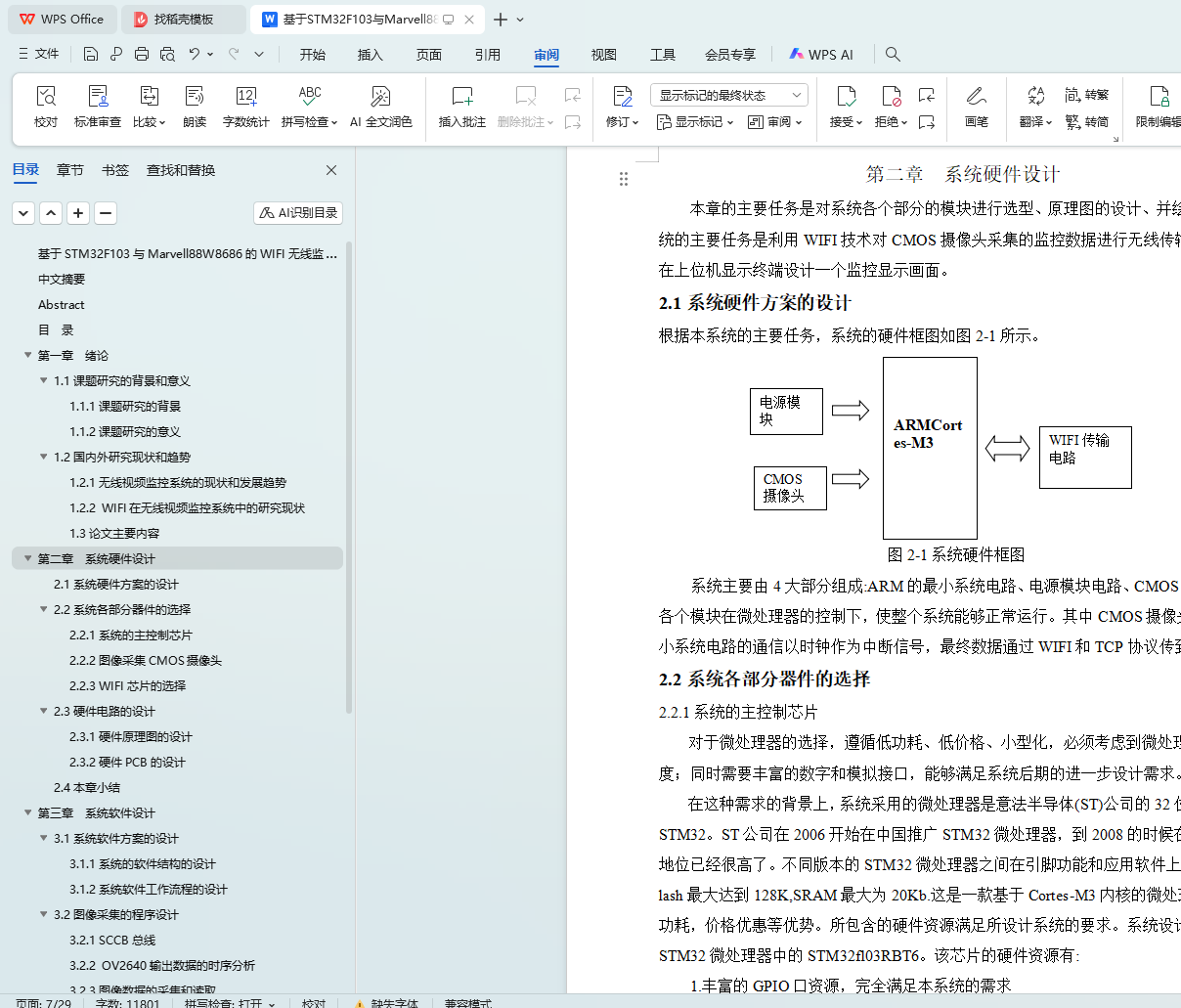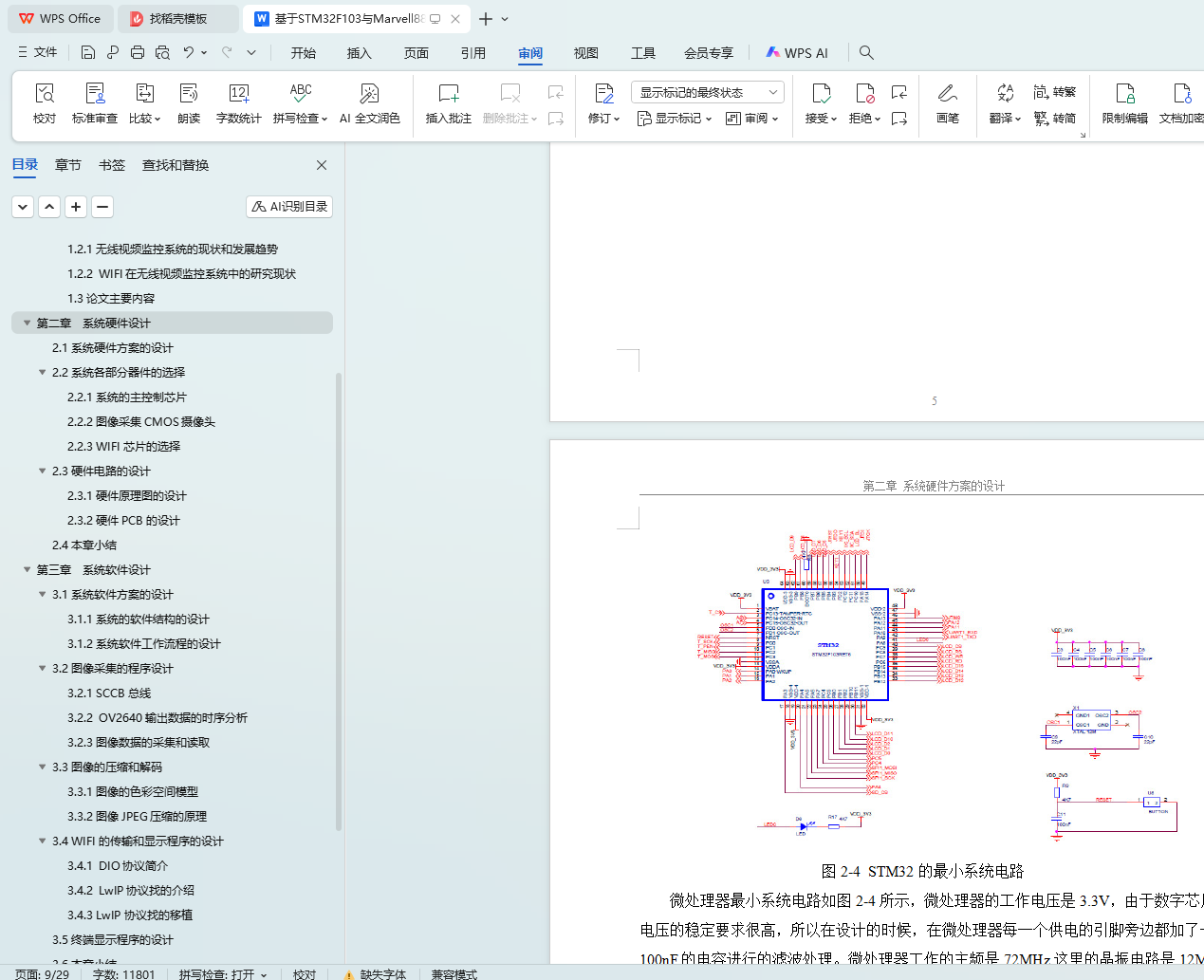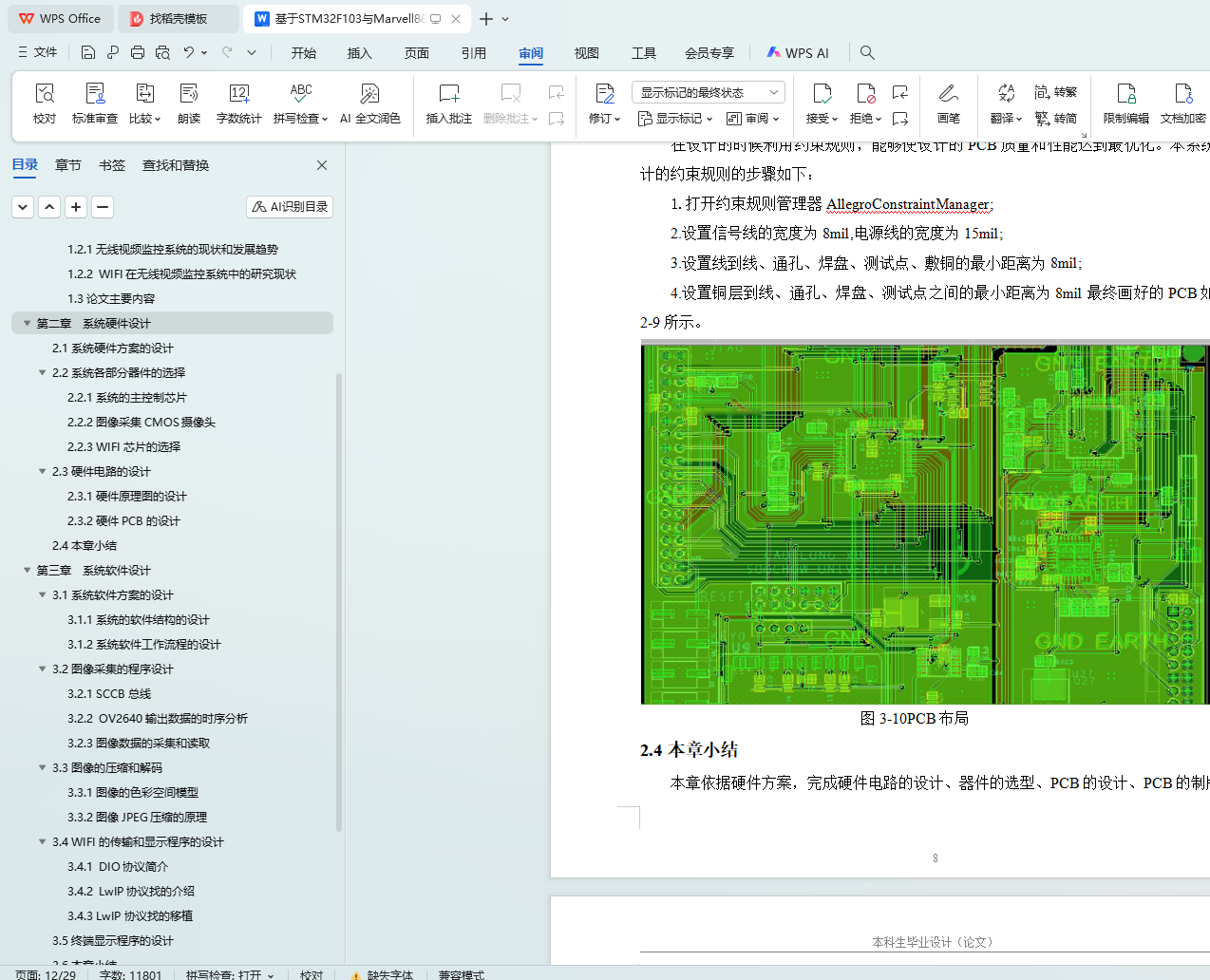基于STM32F103与Marvell88W8686的WIFI无线监控视频传输系统研发
中文摘要
在当今社会信息化进程不断加速的时代背景下,众多领域对于监控系统的需求日益增长,像车内安全监控、电梯运行监控等场景都离不开监控系统的支持。过去,不少领域普遍采用有线传输模式来构建监控系统,尽管这种模式具备传输速率快的优点,但高昂的成本和较大的局限性严重制约了其广泛应用。如今,随着无线技术的蓬勃发展与广泛普及,越来越多的场景开始采用无线传输模式进行监控。无线传输模式不仅克服了有线模式成本高、灵活性差等弊端,还具备移动便捷、开发潜力巨大等诸多优势。
本文设计并实现了一套基于STM32微处理器和WIFI技术的监控视频传输系统。该系统通过CMOS摄像头OV2640采集现场图像,并借助支持IEEE802.11g/b标准的Marvell88W8686无线芯片,利用WIFI网络将采集到的图像实时传输至终端设备。通过在图像采集现场建立稳定有效的通信链路,成功实现了视频的无线传输以及电脑终端对现场情况的实时监控。本系统选用STM32F103作为核心微处理器芯片,确保了系统的稳定运行和高效处理能力。
综上所述,本文完成了该监控视频传输系统的硬件设计与软件编程工作。实验结果表明,该系统能够稳定、流畅地捕捉图像,并通过WIFI网络将视频数据实时传输至终端设备进行显示,达到了预期的设计目标。
关键词:无线传输技术;STM32微处理器;WIFI通信;监控视频传输系统
Abstract
In the current era of accelerating social informatization, the demand for monitoring systems is increasing in numerous fields. Scenarios such as in-car safety monitoring and elevator operation monitoring all rely on the support of monitoring systems. In the past, many fields commonly adopted wired transmission modes to build monitoring systems. Although this mode had the advantage of fast transmission rate, its high cost and significant limitations severely restricted its widespread application. Nowadays, with the vigorous development and widespread popularity of wireless technology, more and more scenarios are beginning to use wireless transmission modes for monitoring. The wireless transmission mode not only overcomes the shortcomings of the wired mode, such as high cost and poor flexibility, but also possesses many advantages, such as convenient mobility and great development potential.
This paper designs and implements a monitoring video transmission system based on the STM32 microprocessor and WIFI technology. The system uses the CMOS camera OV2640 to capture on-site images and, with the help of the Marvell88W8686 wireless chip that supports the IEEE802.11g/b standard, transmits the captured images to terminal devices in real-time via the WIFI network. By establishing a stable and effective communication link at the image capture site, it successfully realizes the wireless transmission of video and the real-time monitoring of the on-site situation by computer terminals. This system selects the STM32F103 as the core microprocessor chip to ensure the stable operation and efficient processing capability of the system.
In summary, this paper has completed the hardware design and software programming of the monitoring video transmission system. Experimental results show that the system can steadily and smoothly capture images and transmit video data to terminal devices for display in real-time via the WIFI network, achieving the expected design goals.
Keywords: Wireless Transmission Technology; STM32 Microprocessor; WIFI Communication; Monitoring Video Transmission System
目 录
摘要………………………………………………………………………………………………I
ABSTRACT……………………………………………………………………………………II
第一章绪论…………………………………………………………………………………1
1.1课题研究的背景和意义…………………………………………………………………1
l.1.1课题研究的背景…………………………………………………………………1
1.1.2课题研宄的意义………………………………………………………………2
1.2国内外研究现状和趋势……………………………………………………………………2
1.2.1视频传输系统的现状和发展趋势………………………………………………2
1.2.2 WIFI在视频传输系统中的研究现状………………………………………………2
1.3论文主要内容…………………………………………………………………………2
第二章系统硬件设计……………………………………………………………………3
2.1系统硬件方案的设计……………………………………………………………………3
2.2系统各部分器件的选择……………………………………………………………………3
2.2.1系统的主控制芯片……………………………………………………………………3
2.2.2图像采集CMOS摄像头…………………………………………………………………4
2.2.3WIFI芯片的选择……………………………………………………………………4
2.3硬件电路的设计…………………………………………………………………………5
2.2.1硬件原理图的设计……………………………………………………………………5
2.3.2硬件PCB的设计………………………………………………………………………8
2.4本章小结……………………………………………………………………………………8
第三章系统软件设计……………………………………………………………………10
3.1系统软件方案的设计……………………………………………………………………10
3.1.1系统的软件结构的设计………………………………………………………………10
3.1.2系统软件工作流程的设计…………………………………………………………10
3.2图像采集的程序设计……………………………………………………………………11
3.2.1SCCB总线………………………………………………………………………………11
3.2.2 OV2640输出数据的时序分析…………………………………………………………12
3.2.3图像数据的采集和读取………………………………………………………………14
3.3图像的压缩和解码…………………………………………………………………………14
3.3.1图像的色彩空间模型…………………………………………………………………14
3.3.2图像JPEG压缩的原理…………………………………………………………………15
3.4 WIFI传输和显示程序的设计………………………………………………………………16
3.4.1 SDIO协议简介…………………………………………………………………………16
3.4.2 LwIP协议栈的介绍…………………………………………………………………18
3.4.3 LwIP协议栈的移植……………………………………………………………………18
3.5终端显示程序的设计……………………………………………………………………20
3.6本章小结……………………………………………………………………………………21
第四章系统运行的情况和分析………………………………………………………………22
4.1监控上位机的显示界面……………………………………………………………………22
4.2本章小结……………………………………………………………………………………22
第五章总结与展望…………………………………………………………………………23
5.1总结………………………………………………………………………………………23
5.2展望…………………………………………………………………………………………23
参考文献……………………………………………………………………………………24
致谢…………………………………………………………………………………………25












